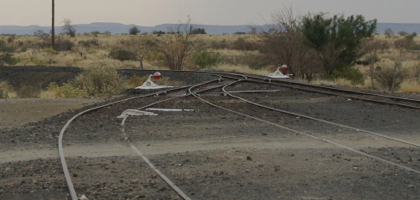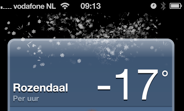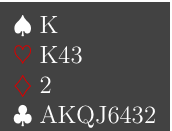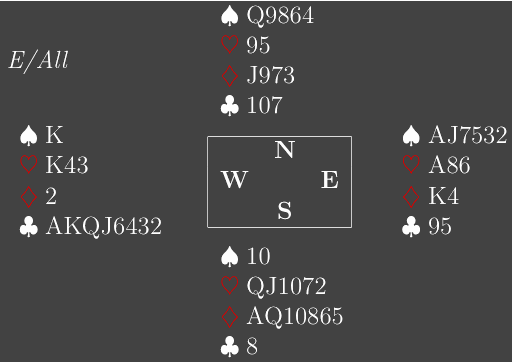
Yesterday’s blog did cause some discussion on the Internet, including:
- ★ The Forum of BridgeBond Nijmegen.
- ★ Facebook (scroll down a bit until you see this topic).
I also got some private mails on this topic. The most interesting one is one where somebody pointed out that the conditions of contest gave a 10 imp maximum carry over from qualifier to the semi-finals. That made the result of the match between HWH and de Lombard 146-138. That is 8 imp’s in favor of HWH. Now remember the actual score in the round robin between HWH and de Lombard... Also 8 imp’s, but this time in favor of de Lombard. I’ll leave it at that.
A good thing is that an official of the NBB told me that in 2013, the day of the team final has been blocked for all other events, so officials and players won’t have an excuse not to attend the team finals and related cocktail party. This was already in the works, so please don’t credit me for this improvement.
In the meantime, it started to freeze here, with record breaking temperatures.

On the right a snapshot from the weather app on my phone taken this weekend. Yes, that is minus 17 degrees and this was at 9:15 in the morning. Obviously, it was colder during the night, some weather stations even reported -23 degrees, a new record in this country. And as always, no matter how hard they try, the Dutch railway system breaks down as soon as the first snowflake falls, leaving me stuck somewhere in the cold waiting for a train to take me home. Fortunately, I did have a laptop and some interesting hands to study with me. That brings me to yesterday’s hand, where you held this hand

and the auction in the National teams final started 1♠ from partner, RHO overcalled 2♠, and it is your turn. At one table, the 1♠ opening is limited to about 15 points and could be canape (meaning that with 4♠ and a 5 card side suit, opener will bid 1♠ rather than his 5 card suit), at the other table 1♠ is standard, 5 or more cards. The overcall showed 5♥ and 5 card minor. Now what?
If you look at the hand, then it is quite obvious what you want to play. Some number of clubs, depending on the number of aces in partner’s hand at the 4, 5, 6 or 7 level. Now, the 4 level will probably be impossible and, as partner has opened the bidding, it is unlikely that he has no aces at all. So, your basic plan should be to show your long suit, then ask for aces. What happened in practice?
At table 1, the auction proceeded like this:

Double is, as far as I can tell from the EW convention card, an attempt to penalize NS. Now, in my wild dreams, my opponents may have clubs as their second suit and I get to defend 3♣x, in practice, the second suit will be diamonds. Not bidding my suit now, will only make it harder to ever introduce clubs. That seemed to happen in practice too. North’s first pass was neutral, that is no preference for any suit. 3♠ was a bit unclear as to suit strenghts, west apparently could not bid 4_ as a forcing bid and had to settle for a vague cuebid. Finally, 6♠, would you feel comfortable putting down this hand as dummy without ever having suggested your solid 8 card suit as trumps? No, neither would I, in particular since there is no way to tell that the 6-1 spade fit is even remotely playable.

We now turn to table 2. Here the auction continued as follows. West made the sensible bid of asking for aces, planning to sign off in some number of clubs. EW play 14-30, so with all responses, west could simply bid the right number of trumps. Well, no. First the 5♠ response which cannot exist if there is no trump suit. West probably smelled a rat but could not do anything but 6♣. And west was right, east assumed that spade was the trump suit and 6♣ was some sort of grand slam try for spades. West did bid the grand but with little hope to make it. He was right, as the full deal was:

6♠ went down 3, 7♣ down 1, so EW at table 2 were probably very pleasantly surprised to win 5 imp’s after intentionally bidding a grand off an ace.
Is there a way to avoid this disaster? Well, I’m not sure about the EW methods at table 1, but for EW at table 2, here is an extremely useful rule to make in Blackwood situations.
If no trump suit has been set, but there is a forcing bid to set the trump suit, a jump to 4NT is regular Blackwood (that is, 4 real aces, not the trump K), not Keycard Blackwood (4 aces plus the trump K). If partner wants to use Keycard Blackwood, he should first set the trump suit and then ask for aces.
Here 3♥ in the first round would probably set spades as trumps, so the failure to bid this makes that there is no trump suit and hence only 4 real aces. Note that this would also work if NS had passed, after 1♠, west simply bids 4NT and ends up in the right number of clubs. Simple and useful, add this to your system notes.
